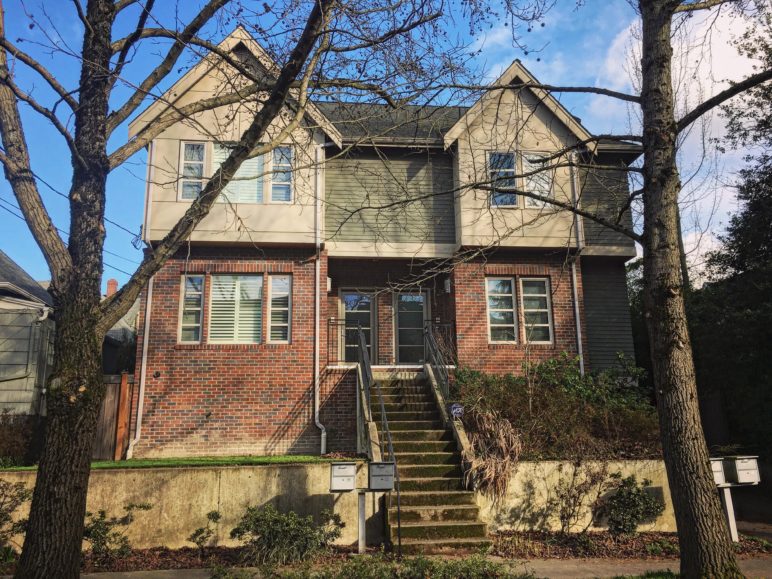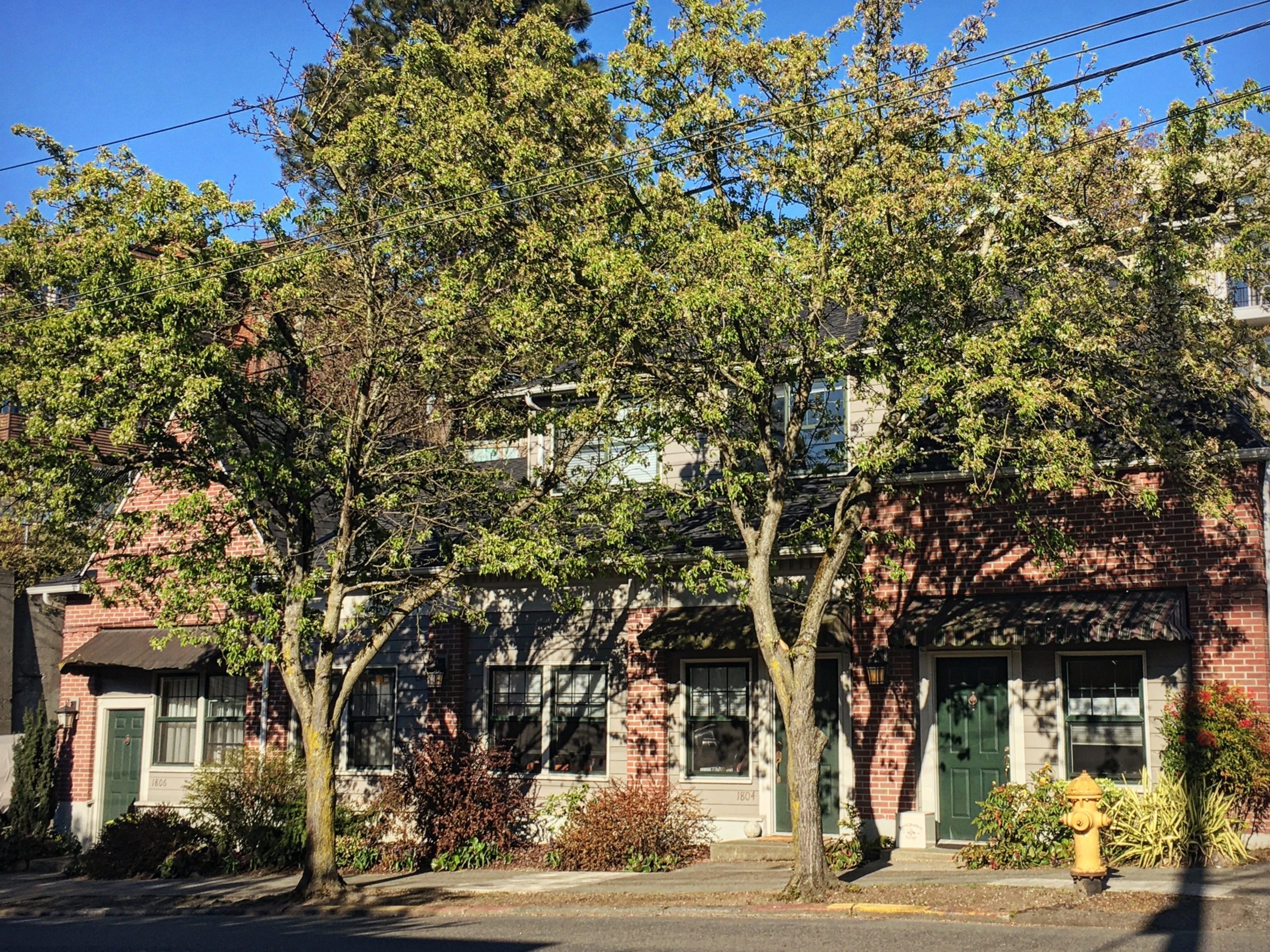UPDATE: The House declined to give HB 1782 a floor vote by the February 15 deadline and the bill is dead. Previously,the bill had passed out of the Appropriations and Local Government Committees.
UPDATE: Senate companion SB 5670 passed out of the Senate Housing & Local Government Committee but did not receive a hearing in the Senate Ways & Means Committee, which means HB 1782 is now the sole vehicle.
UPDATE: New polling finds finds fully 61% of voters across Washington state support this middle housing legislation to expand more affordable housing types, with 41% strongly supporting.
Download a cheat sheet explaining 18 reasons why Washington should legalize middle housing. Sign up here for action alerts and legislative updates.
…
Washington could become the third West Coast state to lift local laws that ban multi-dwelling homes like duplexes and townhouses, opening the doors to “middle housing” options for hundreds of thousands of families throughout the state.
A new bill would not only help correct the historic injustice of zoning laws originally enacted to exclude Black families, but also would relieve the root cause of Washington’s housing crisis: a shortage of homes. And more middle housing means more affordable home choices near jobs and schools, and transit, and more options for first-time homebuyers.
By one estimate, home building for the fast-growing population of Washington state fell behind the need by 225,000 homes from 2000 to 2015—and it has only gotten worse since. Today, Washington officials project that the state will produce around 43,000 homes per year through 2030. Even if all of those homes went toward the state’s current deficit, it would take five years to catch up. But that’s assuming the state’s growth halts, which it won’t.
Compared with typical apartment buildings, middle housing yields fewer homes per lot, but there’s power in numbers: Washington has about 1.8 million detached houses occupying roughly three-quarters of the state’s residential land. If middle housing were legalized, only a fraction of those house lots would gain homes, but that small share would still be enough to help pull Washington out of its housing shortage. Extrapolating from a California study, legalizing fourplexes throughout Washington could make more than 200,000 more homes not only legal, but also financially feasible for builders to construct.
For a second comparison, a recent University of Washington report estimated that legalizing fourplexes within a quarter-mile of transit stations would create capacity for nearly half a million more homes in the Puget Sound region, which is home to 4.3 million of the state’s 7.6 million residents. If a fifth of that capacity eventually saw construction, that’s 100,000 homes.
Washington’s hot-off-the-presses middle housing bill has a unique formula (see below), so no one has yet done the math to project exactly how many built homes it could yield. What we do know, though, is that it will legalize the potential for hundreds of thousands more homes for individuals and families that need them all across the state.

Legalizing sixplexes, fourplexes, and duplexes
Washington’s proposed companion bills, SB 5670 and HB 1782, prioritized by Governor Jay Inslee and sponsored by Senator Mona Das and Representative Jessica Bateman, would legalize middle housing in three tiers, depending on proximity to transit and city population:
- Up to sixplexes on all residential lots within a half-mile of a major transit stop in cities with populations of 20,000 or more.
- Up to fourplexes on all residential lots elsewhere in cities of 20,000 or more.
- Duplexes on all residential lots in cities with populations of at least 10,000.
A second key piece of the bill would limit parking mandates. On-site parking is often incompatible with cost-efficient middle housing design. For middle housing within a half-mile of transit in cities of 20,000 or more, the bill would lift all parking mandates. Elsewhere, the bill would cap mandates for middle housing at no more than one parking stall per lot on lots 6,000 square feet or smaller, and at no more than two stalls per lot on lots larger than that.
To protect existing communities from displacement pressures that could be exacerbated by middle housing reforms, the bill includes anti-displacement measures for rezoned areas within a half-mile of transit. It would require that cities take the actions defined by a 2021 bill that established new anti-displacement standards for local planning.
While setting a statewide baseline standard for middle housing, the bill would also provide flexibility and support for local governments:
- Cities would retain control over siting and design as long as the rules aren’t any more restrictive that those that apply to detached houses. But the bill would also set a “reasonableness standard” to prevent local restrictions that would render middle housing all but impossible to build, even if technically legal.
- Cities enacting the required zoning reforms would be immune from appeals and lawsuits on those actions under the State Environmental Policy Act or Growth Management Act.
- Cities would have two years to pass the required zoning changes, and those with unusual infrastructure limitations could apply for delayed implementation.
- The Governor’s 2022 budget includes $3.5 million for the Department of Commerce to assist local governments in implementing middle housing zoning reforms.
Lastly, the bill offers an alternative path for compliance, under which cities could, instead of legalizing fourplexes and duplexes, opt to enact zoning that allows a specified minimum average housing unit density for the city as a whole. The bill’s required minimum average density is tiered by population:
- 500,000 or more: 40 dwellings per gross acre (DU/AC)
- 100,000 to 500,000: 30 DU/AC
- 20,000 to 100,000: 25 DU/AC
- 10,000 to 20,000: 15 DU/AC
Cities choosing this alternative path would have to “adopt findings of fact demonstrating that actions taken to implement the average minimum density will not result in racially disparate impacts, displacement, or further exclusion in housing.”
Five initial takes on Washington’s middle housing bill
- One notable difference between Washington’s new bill and the middle housing laws passed in Oregon and California is that it boosts the allowance for homes to six per lot near transit. Focusing housing growth near transit is nationally established best practice.
- The bill excludes lots in unincorporated areas, even if urban. Such areas may encompass perhaps as much as a third of urban house lots. Extending the bill to unincorporated urban areas would bring middle housing options to even more Washingtonians.
- The elimination of off-street parking mandates within a half-mile of transit would be a huge win, not only for housing, but also for climate stability, environmental justice, farm and forest protection, and for helping the state meet its goals for reducing vehicle miles traveled. Going a step further to completely eliminate parking requirements for all middle housing would extend those benefits.
- The minimum density alternative compliance path leaves open the possibility that cities could retain exclusionary detached-house zoning over large portions of their residential land. However, the bill’s “findings of fact” requirement is a high legal bar for cities to meet.
- Many cities with populations of less than 10,000 are located in urban areas and have exclusionary detached house neighborhoods with high housing prices (think of Seattle-area enclaves like Normandy Park or Medina). To include such cities while continuing to exempt less wealthy, rural small cities, legislators could lower the bill’s population cutoff but also limit applicability to cities in urban areas as defined by the US Census.
Washington legislators have the opportunity to become national leaders in the growing movement to end exclusionary zoning, the local laws that ban homes like triplexes and rowhouses. Passing HB 1782 to legalize these middle housing options would help ease the statewide housing shortage and provide homes to more Washingtonians, wherever they wish to live, work, learn, and recreate throughout the state.
Download this cheat sheet that spells out all the reasons why Washington should legalize middle housing. Sign up here for action alerts and legislative updates.


